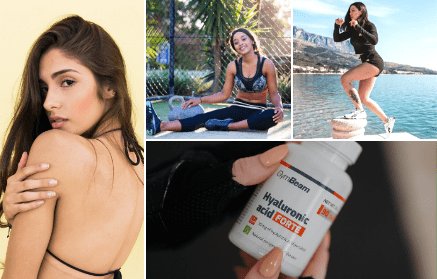Table of Contents
Hyaluronic acid has become recently popular for its beneficial effects on the skin, especially the reduction of wrinkles. However, acid with a name that is a tongue twister is useful for example in wound healing and reflux treatment. Read in our article, what hyaluronic acid is, and what are the benefits of its use.
Hyaluronic acid origins
The name hyaluronic has its origins in the Greek word hyalos, which can be translated as glassed. Hyaluronic acid is naturally found in the human body, along with its sodium salt form synovial fluid. Its role is to moisturize soft tissues that support the flawless functioning of certain human joints. The synovial fluid reduces friction and facilitates the movement between cartilages. You can find hyaluronic acid in concentrated form in the eye liquid. [1] [3] [4]

The hyaluronic acid molecule, also known as hyaluronan, is in structure a high viscous mucopolysaccharide, formed from recurrent glucoside units. As is apparent from the parts of the names “Saccharide” and “Gluko” part of it is “sugar”, more accurately glucose. Glucoside is the designation of bioflavonoids which are attached to glucose, while the glucose molecule fulfills the function of the transporter. [1] [2]
Hyaluronic acid was first isolated from cow’s intraocular fluid in 1934. It was isolated by Karl Meyer and John Palmer and named it by combining the terms hyaloid (glassed) and uronic adic (uronic acid). In 1986, the term Hyaluronan was subsequently introduced, to match the saccharide terminology. [5]
You might be interested in these products:
Hyaluronic acid functions
Improves activity and reduces pain in joints
The proper functioning of the joints depends on their moisture, thanks to it, there is no friction which is a source of pain. This function is fulfilled by synovial fluid which contains hyaluronic acid. The acid dissolves in the fluid which contributes to the pain and joint stiffness.[6] [12]
Moisturizing of joints is particularly important for people suffering from osteoarthritis, for whom the hyaluronic acid application may reduce stiffness and pain. Osteoarthritis is a disease that affects millions of people around the world, it is the most common type of arthritis. While arthritis is a sign of inflammation of the joints which can represent 200 different health conditions. In the case of osteoarthritis, we talk about the difficulties caused by the disjoint of the cartilage in the joint. Osteoarthritis is most commonly related to the knees, hips, and spine, but also affects the joints of the fingers or the wrist joints (the lower joint of the thumb) and the tarsometatarsal joint (the bottom joint on the big thumb). [8] [9] [10] [11]

The scientific review of 2016 evaluated the results of studies between the years 2008 and 2015. The results of the review confirmed the positive effect of the usage of hyaluronic acid in the treatment of symptoms associated with synovitis. This term indicates inflammation of the synovial membrane which is painful, especially when moving. Hyaluronic acid in the form of supplementation exhibits moderate efficacy without side effects. This is a safe substance for the purpose of alleviation knee pain. [14] [15]
Improves wound healing
Hyaluronic acid is found in synovial fluid, in the eye area, but is also a natural part of the skin. The concentration of acid increases for reparation of damaged skin. Hyaluronic acid can affect the speed of healing due to the regulation of inflammation and the notification of the body to create a higher number of vessels in a damaged place. [6]
The research of 2015 studied the ability of hyaluronic acid to reduce skin dying. For these purposes, they created an experimental model of dermal toxicity (skin damage) and hepatotoxicity (liver damage) caused by ethanol. They used the human’s keratinocytes (cells of the epidermis that produce keratin) and hepatocytes (epithelial cells of the liver) that preserve the induced activity of cytochrome P450 (enzymes needed for the synthesis and metabolism of various molecules and chemicals in the cells). According to the results, the skeleton codes from hyaluronic acid were used to insert the fibroblastic growth factor. The fibroblasts are the types of cells that create extracellular matrix and collagen. These two components are important for the formation of structural tissue and also for the repair of tissues. In isolation or in combination with other components, the acid is used for the purpose of reparation of tissues. The extracts from hyaluronic acid are effective and safe for the needs of the skin reparation. [17] [22] [23] [24] [25]
The importance of hyaluronic acid for the treatment of chronic wounds and its ability to accelerate this process is already proven. The 2006 study focused on verifying whether acid can be successful even in the improvement of the healing of acute wounds. The research involved 43 patients with different types of wounds, such as burns, wound injuries, surgical thighs, or dermabrasion. Hyaluronic acid was used in the form of cream or patch and the results were evaluated after each of the total 9 applications. The study showed the following findings [18] [20] [21]:
- reduction of 70% of the wound area after the 6th measurement
- 56% of cases were completely healed after the 6th application
- 91% of cases showed little or no fibrin (a protein in blood clotting)
- 84% of cases showed little or no exudate (fluid leaking from blood vessels due to inflammation)

Relieves gastric reflux symptoms
Reflux is an unpleasant condition in which stomach contents return to the throat resulting in damage to the esophagus. Hyaluronic acid may be useful in the alleviation of the reflux symptoms, thanks to the healing of the lining of the esophagus. [6]
Several sources refer to the use of the combination of hyaluronic acid and chondroitin sulfate in the treatment of reflux symptoms. The research of 2012 deals with the use of a product called Esoxx, which is the mixture of hyaluronic acid and chondroitin sulfate. The results indicate the product’s success in reducing the permeability of the damaged mucosa, which supports further clinical studies in the treatment of reflux.[6] [19]
The effect of hyaluronic acid on the skin
The most popular benefits of the use of hyaluronic acid are the effects on the skin. You may also well know the advertisement that highlights the hyaluronic acid feature to improve skin quality, moisturize, and remove wrinkles. The study of 2017 examined the ability to slow skin aging by means of supplements, while the participants were divided into groups with placebo and hyaluronic acid (HA 2 K and HA 300 K). The research involved men and women of the age from 22 to 59 years and its length was 12 weeks. Scientists have evaluated the changes in wrinkles around the eyes (crow ́s feet wrinkles) by comparing the photos before and after taking hyaluronic acid, but also a questionnaire. The results have shown that oral supplementation of hyaluronic acid reduces wrinkles and improves skin condition. The microscopic photographs attached to the study adequately point out to the skin improvement. [12] [13]

The research of 2014 assessed the effectiveness of the low-molecular-weight preparation (Nano-hyaluronic acid) for skin hydration, treatment of wrinkles, and skin elasticity. The research involved 33 women with an average age of 45.2 years for 8 weeks. During the measurement of skin roughness the improvement had been observed already 2 weeks after, and progress in skin elasticity after 2 and 8 weeks of the research. After an 8-week period, a major improvement was found in 3 areas [16]:
- improvement of skin hydration (up to 96%)
- reduction in the depth of wrinkles (up to 40%)
- increase of the elasticity and firmness of the skin (up to 55%)
Based on the results of the studies, it can be seen that hyaluronic acid can improve the vitality of the skin, that naturally changes, and wrinkles occur with age. We do not get older all in the same and therefore there are many factors during a life that have effects on the reduction of health or the condition of the body. Also, the age slowing effect of hyaluronic acid is different for everybody. Among the factors affecting it are the diet, alcohol and cigarette consumption, genetics, air pollution, and exposure to sunlight. [12]
Side effects and risks
The human body naturally produces hyaluronic acid, therefore allergic reactions to it are very rare. The use of acid in form of tablets and creams is considered to be safe. The exception is the injection during which the application into the joint may cause redness. In the same way, pregnant and nursing women should be cautious when taking hyaluronic acid, but also people with a history of anaphylaxis and other serious allergic reactions. Therefore, if you belong to one of these groups, you suffer from chronic illness or you are taking medicines, it is advisable to consult with your doctor before taking it. [4] [6] [8]

Which form of hyaluronic acid is most effective?
Hyaluronic acid is a popular component in various products, in addition to the tablets we find it, for example, in the form of daytime and nighttime creams, serums, lipsticks. However, it is also applied through injections. Local use on the skin is effective for the ability of the acid to retain 1000-times its weight on water, therefore it has great moisturizing properties. The acid keeps the water on the skin surface, increasing the hydration of the cells. [7]
When choosing a cream containing hyaluronic acid, focus on hyaluronic acid or sodium hyaluronate which is a derivative of hyaluronic acid. The fundamental difference between these forms is solubility because sodium hyaluronate is characterized by better absorption into the skin. Another important information that should be of interest to you on the product packaging is the content of hyaluronic acid. The best choices are creams and serums with a content of at least 1% acid, However, if this is not indicated on the packaging, it is better to choose products that do not have that hyaluronic acid at the very end of the composition list. [27]
It is believed that dietary supplements containing hyaluronic acid that is intended for oral use may have the same effects as serum or injections. Hyaluronic acid, which has come through a digestion tract can function in three ways. The part of the acid is absorbed in intact form, another part breaks into sugars which are absorbed in this form. The third function is promoting the spread of beneficial bacteria in the digestive tract, leading to an overall improvement of health, immunity, and even joints. [8] [26]
Experts on alternative medicine consider hyaluronic acid to be useful in the treatment of even unrelated diseases, such as insomnia, osteoporosis, chronic fatigue syndrome, chronic pain, or ventricular dysfunction. The level of support in the form of scientific studies differs and some can be classified up to the position of the pseudoscience. It is therefore important to consider only the scientifically substantiated effects of hyaluronic acid. [8]
Usage of hyaluronic acid
There is no formal and universal guidance on the correct oral use of hyaluronic acid. The recommended daily intake is 200 mg with some producers, while others report up to 1 000 mg. The best solution is probably to follow the dosage indicated on the package. There is no evidence which would confirm that using higher doses achieve better results. Daily intake of hyaluronic acid was in several studies not exceeding 240 mg. [8]
Hyaluronic acid is a natural part of the human body, but its concentration decreases, which can lead to aging of the skin and problems with joints. The supplementation of hyaluronic acid was and is scientifically investigated and the results confirm its positive impact without side effects. We believe that you’ve learned everything necessary about hyaluronic acid. Do you want your friends to learn about its health benefits? Feel free to support article by sharing.
[1] Hyaluronic acid – https://www.acs.org/content/acs/en/molecule-of-the-week/archive/h/hyaluronic-acid.html
[2] Kamal Patel - Glucosides and Glycosides – https://examine.com/nutrition/glucosides-and-glycosides/
[3] Synovial Fluid Definition – https://www.arthritis-health.com/glossary/synovial-fluid
[4] HYALURONIC ACID – https://www.webmd.com/vitamins/ai/ingredientmono-1062/hyaluronic-acid
[5] Ramesh C. Gupta, Rajiv Lall, Ajay Srivastava, Anita Sinha - Hyaluronic Acid: Molecular Mechanisms and Therapeutic Trajectory – https://www.ncbi.nlm.nih.gov/pmc/articles/PMC6603175/
[6] Erica Julson - 7 Surprising Benefits of Hyaluronic Acid – https://www.healthline.com/nutrition/hyaluronic-acid-benefits
[7] Dana Oliver - What Hyaluronic Acid Is, And Why It May Be Your Dry Skin Savior – https://www.huffpost.com/entry/what-is-hyaluronic-acid_n_569f9978e4b0fca5ba7607f4
[8] Cathy Wong - The Health Benefits of Hyaluronic Acid Supplements – https://www.verywellhealth.com/hyaluronic-acid-supplements-89465
[9] Osteoarthritis - – https://www.mayoclinic.org/diseases-conditions/osteoarthritis/symptoms-causes/syc-20351925
[10] Hannah Nichols - What are the causes and types of arthritis? – https://www.medicalnewstoday.com/articles/7621
[11] What's the difference between arthritis and osteoarthritis? – https://www.webmd.com/osteoarthritis/qa/whats-the-difference-between-arthritis-and-osteoarthritis
[12] Jamie Eske - Everything you need to know about hyaluronic acid – https://www.medicalnewstoday.com/articles/326385
[13] Mariko Oe, Seigo Sakai, Hideto Yoshida, Nao Okado, Haruna Kaneda, Yasunobu Masuda, Osamu Urushibata - Oral hyaluronan relieves wrinkles: a double-blinded, placebo-controlled study over a 12-week period – https://www.ncbi.nlm.nih.gov/pmc/articles/PMC5522662/
[14] Mariko Oe, Toshiyuki Tashiro, Hideto Yoshida, Hiroshi Nishiyama, Yasunobu Masuda, Koh Maruyama, Takashi Koikeda, Reiko Maruya, Naoshi Fukui - Oral hyaluronan relieves knee pain: a review – https://www.ncbi.nlm.nih.gov/pmc/articles/PMC4729158/
[15] Synovitis – https://www.healthcentral.com/condition/synovitis
[16] S. Manjula Jegasothy, Valentina Zabolotniaia, Stephan Bielfeldt - Efficacy of a New Topical Nano-hyaluronic Acid in Humans – https://www.ncbi.nlm.nih.gov/pmc/articles/PMC3970829/
[17] Neuman MG, Nanau RM, Oruña-Sanchez L, Coto G. - Hyaluronic acid and wound healing. – https://www.ncbi.nlm.nih.gov/pubmed/25877441
[18] Voinchet V, Vasseur P, Kern J. - Efficacy and safety of hyaluronic acid in the management of acute wounds. – https://www.ncbi.nlm.nih.gov/pubmed/17173469
[19] Massimo P Di Simone, Fabio Baldi, Valentina Vasina, Fabrizio Scorrano, Maria Laura Bacci, Antonella Ferrieri, Gilberto Poggioli - Barrier effect of Esoxx® on esophageal mucosal damage: experimental study on ex-vivo swine model – https://www.ncbi.nlm.nih.gov/pmc/articles/PMC3387832/
[20] William C. Shiel - Medical Definition of Fibrin – https://www.medicinenet.com/script/main/art.asp?articlekey=3450
[21] William C. Shiel - Medical Definition of Exudate – https://www.medicinenet.com/script/main/art.asp?articlekey=9900
[22] keratinocyte – https://www.merriam-webster.com/dictionary/keratinocyte
[23] hepatocyte – https://www.merriam-webster.com/dictionary/hepatocyte
[24] Cytochrome p450 – https://ghr.nlm.nih.gov/primer/genefamily/cytochromep450
[25] Ananya Mandal - What are Fibroblasts? – https://www.news-medical.net/health/What-are-Fibroblasts.aspx
[26] How Does Oral Hyaluronic Acid Work? – https://www.purityproducts.com/blog/how-does-oral-hyaluronic-acid-work
[27] Angela Palmer - Should You Add Hyaluronic Acid to Your Skincare Routine? – https://www.verywellhealth.com/hyaluronic-acid-for-skincare-4582343


Add a comment